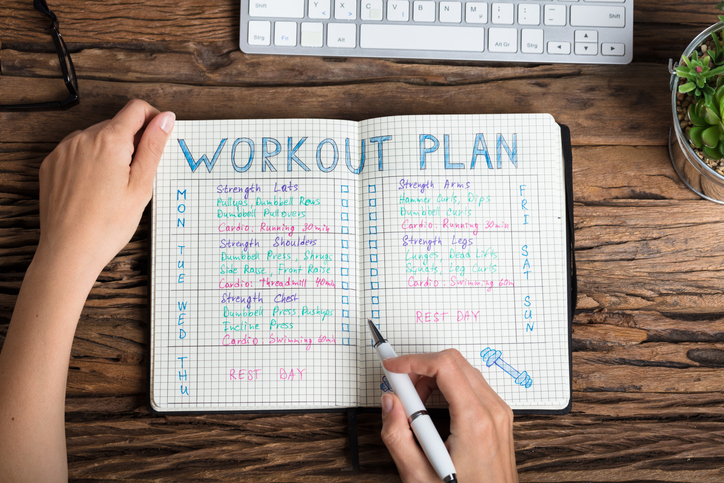Perhaps we have all been advised: “Let’s exercise because it’s good for health.” Research in the Lancet has also demonstrated the benefits of exercise.
According to scientists, you can reduce the risk of colorectal cancer by 30-40%, the risk of breast cancer by 30%, the risk of type 2 diabetes by 20-60% and the risk of type 2 diabetes by 30-50%. chance of premature death from all causes if you give up a sedentary office lifestyle.
But ironically, despite all the emotional advice and even the random numbers, not everyone builds a fitness routine, especially busy young people. In some cases, people claim to be not lazy, but they hate exercise and even fear it.
But why is that? And if exercise helps, how do we overcome those mentality?

Humans didn’t evolve to ‘exercise’
Well, that’s a good excuse for you, if you don’t want to exercise. For most of human history, our ancestors lived with food scarcity.
That is why humans are born with strong legs, to move continuously for millennia in search of food. After each full meal, our ancestors would rest to conserve energy.
Because really, they don’t know if they can find their next meal. So don’t waste your energy pushing weights or jogging. Fitness (non-survival meaningless movement) is not imprinted on our genomes.
So, if after a tiring day at the office, you just want to go home to shower, eat and then lie down on Facebook, watch Netflix instead of going to the gym, just comfort yourself, that’s a trend. human nature.


However, again and again, humans did not evolve to exercise, nor did we evolve in time to adapt to a sedentary lifestyle. Meanwhile, science and technology in the 21st century is tending to turn us into creatures that sit still rather than walk around to find food.
If you notice, people have never been as lazy and have many seats as they are now. Chairs are found in offices, trains, cafes, restaurants, pubs, cars, concert halls, cinemas, operating rooms, hospitals, schools, lecture halls, and in every home. our house. (I guarantee your house has more chairs than you think).
If we try to estimate the number of chairs available in the world, the number can reach more than 60 billion units. It wouldn’t be surprising if every person on the planet was given eight to ten chairs.

Research conducted by the British Heart Foundation suggests that people are enjoying around 9.5 hours of sedentary activity each day. This means that modern humans are inactive for about 75% of their life time.
Cons: Sitting too much makes our spine weak. Back pain is now a leading cause of disability.
The health status of every hard and soft tissue in our body can be summed up by one maxim “use it of lose it“. Muscles and bones that are used a lot grow and weaken when you are lazy. The level of physical activity is what determines whether your bones will be stronger or thinner and muscles will be stronger or smaller.

Sitting, with most of the muscles in the body relaxed, weakens everyone and also makes us age rapidly. A 2012 study examining data on 7,813 women found that those who sat for more than 10 hours a day had shorter telomeres, indicating that their cells age faster and life expectancy is shortened by up to 8 hours. five.
Rapid aging not only shortens our lifespan, but also shortens the years we live in the most stable health (healthspan), by pushing people into disease conditions, from disease osteoarthritis, cardiovascular, to diabetes and cancer.
So that’s why people need exercise every day
As recommended by the World Health Organization (WHO), every adult should get at least 150 minutes of moderate-intensity physical activity each week, although the ideal number is 300 minutes.
Moderate intensity activities are counted as activities that cause:
– You breathe fast, but evenly without being out of breath
– You sweat lightly after 10 minutes of exercise
– You can talk but can’t sing
If you aim for 150 minutes of that workout per week, that equates to 30 minutes a day for 6 days. For 300 minutes, that’s an hour a day, and you take a day off each week.
But if you don’t have the time, the WHO says you can achieve the same health goal with 75 minutes of intense exercise a week, ideally 150 minutes. High-intensity exercises are exercises that make you:
– Breathe deeply and quickly
– Sweating after just a few minutes of exercise
– You can’t speak fluently because just saying a word will make you pause to catch your breath
How to get rid of the mentality of inactivity and exercise?
According to psychologists, there are two main types of motivation that motivate us to work: One is extrinsic motivation and the other is intrinsic motivation. Intrinsic motivation comes from within – it makes you do something because you enjoy doing it yourself or you feel challenged to do it yourself.
Meanwhile, extrinsic motivation comes from objective factors, such as a reward or you simply do to avoid punishment. For exercise, and especially for maintaining a fitness routine, you need to boost both your intrinsic motivation and your extrinsic motivation.
Here are 10 psychological tips to help you do just that:
1. Identify why you exercise

It must be a reason of your own. For example, you know you need exercise to stay healthy. And only when you have good health, you can do other things like increase your work productivity, take care of your loved ones, or even more distantly, live until the day you see your children and grandchildren grow up.
The more personalized your fitness goals are, the more motivated you’ll be to stick to the routine. For example, if you set a goal to conquer a mountain or run a marathon by the end of the year, the clearer the goal, the more motivated you will be to take action.
2. Find someone to practice with you
Research shows that if people exercise with friends or family members, they will maintain a longer and more stable exercise routine. That’s because they feel more motivated, and a sense of belonging, or even being watched, motivates people to take more action.
3. Reward yourself
Buy yourself a new set of workout clothes or a new pair of shoes. For many people, their motivation to go for a run or hit the gym is simply that. Similar to other exercises such as swimming, badminton, tennis… Don’t forget to reward yourself every time you achieve a certain goal. And set a reward to motivate yourself to achieve it.
4. Track your workouts

Some wearable devices such as smart watches, health bracelets can become a good assistant for you in the process of tracking exercise. Only when you are able to track your training will you feel the progress and therefore be motivated.
In addition, exercise apps on the phone, with reminders, self-monitoring and goal setting are also very useful. There’s a lot of research showing that a workout tracker will increase your motivation.
5. Make exercise a habit
Research shows that exercising in the morning helps form habits faster than exercising in the evening. However, no matter what time and day of the day or week, if you set yourself a workout routine and stick to it long enough, you’ll make it a habit that’s hard to break.
6. Let’s start with a favorite sport
Starting a new exercise routine is hard work. So try that by choosing an activity that you find interesting. For example, if you like to walk, go for a walk. If you enjoy swimming, start swimming.
If you feel self-conscious about your body when you go to a crowded gym, don’t force yourself to do it right away. Choose an initial form of exercise that you feel most comfortable with.
7. Start with small goals

If you’re starting your first session, don’t set your expectations too high. Expectations that are too high on the one hand can lead to disappointment when you don’t meet them. On the other hand, overtraining in the early days can put you at risk of injury.
Both are not good for exercise. It is best to set small goals and increase them every day. You will both feel motivated when achieving them, and see your own progress.
8. Listen to music
Rhythmic music has been shown to improve mood and reduce stress during exercise. Music is especially effective for repetitive, rhythmic forms of exercise, such as walking and jogging.
9. Take your pet for a walk
Walking your dog is proven to be a mild form of exercise but has many benefits, from getting you moving to increasing social connections in your area. In addition, many people who feel scared while walking outdoors at night also feel safer when they take their dog with them.
10. Try to think about finances
Behavioral economic theory posits that people are motivated to act by loss avoidance. Just imagine if you don’t exercise for 5 years or 10 years, your health could go down to the point where you can’t work anymore. In addition, having some chronic diseases such as back pain, obesity, even cancer, how much money will you lose for those problems.
In addition, you can set short-term financial penalties for yourself, if you want to motivate yourself to exercise. For example, penalize yourself an amount per day if you don’t exercise, and a larger amount per month if you don’t reach your goal.

In the end, whichever tip you choose, remember that exercise should be a long-term habit. If you keep exercising for the rest of your life, it will benefit your health for a lifetime.
Looking at that whole journey, taking 3-4 months to discipline yourself and build a workout routine is clearly not something overwhelming and pointless right? Remember that humans are not born to exercise, but we need exercise to stay healthy.
Refer to Theconversation
